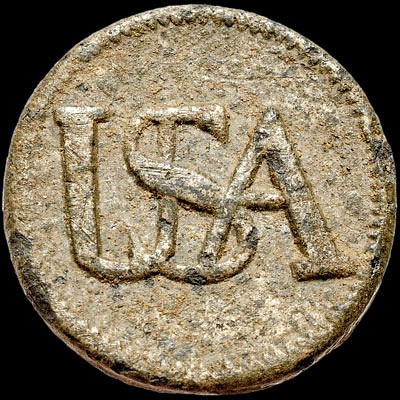1756 MASS. Document 4 Pence Embossed Revenue Stamp STEADY STEADY Scott Cat. RM4
Lot 49
Estimate:
$500 - $600
Absentee vs Live bid
Two ways to bid:
- Leave a max absentee bid and the platform will bid on your behalf up to your maximum bid during the live auction.
- Bid live during the auction and your bids will be submitted real-time to the auctioneer.
Bid Increments
| Price | Bid Increment |
|---|---|
| $0 | $10 |
| $200 | $20 |
| $300 | $25 |
| $500 | $50 |
| $1,000 | $100 |
| $2,000 | $200 |
| $3,000 | $250 |
| $5,000 | $500 |
| $10,000 | $1,000 |
| $20,000 | $2,000 |
| $30,000 | $2,500 |
| $50,000 | $5,000 |
| $100,000 | $10,000 |
| $200,000 | $20,000 |
| $300,000 | $25,000 |
| $500,000 | $50,000 |
About Auction
By Early American History Auctions
Aug 21, 2021
Set Reminder
2021-08-21 12:00:00
2021-08-21 12:00:00
America/New_York
Bidsquare
Bidsquare : Autographs - Historic & Political Americana - Militaria & Guns
https://www.bidsquare.com/auctions/early-american-history-auctions/autographs---historic-political-americana---militaria-guns-7321
335 Lots of Rare, Historic Autographs, Americana, Civil War Era, George Washington, Revolutionary War Era, Colonial America, Federal Period, War of 1812, Colonial Currency & more... Early American History Auctions auctions@earlyamerican.com
335 Lots of Rare, Historic Autographs, Americana, Civil War Era, George Washington, Revolutionary War Era, Colonial America, Federal Period, War of 1812, Colonial Currency & more... Early American History Auctions auctions@earlyamerican.com
- Lot Description
Colonial America
1756 Massachusetts Document with Paid 4 Pence "Sailing Ship" Vignette Embossed Revenue Stamp "Steady Steady"
November 7, 1756-Dated French & Indian War Period, Manuscript Document Signed, "Benajmin Curtis," with Colonial Massachusetts "STAMP ACT" Embossed 4-Pence "Sailing Ship" vignette Revenue Stamp, Scott Cat. RM4, Choice Very Fine.
This original Land Sale Document is dated 1756, at Scituate, Massachusetts, 1 page, beautifully written on clean period laid paper, measuring 7.5" wide x 12" tall, where Benjamin Curtis has sold to Seth Thompson a certain tract of land in Wells, Maine (then part of Mass.). Signed at bottom by Benjamin Curtis, Benjamin Curtis Jr., David Sewall, Dorothy Wells, and at left margin by John Storer (known as the "chief Indian fighter" of the region). Embossed "IV Pence" Revenue Stamp is located at upper left, is very clear in detail, which reads "STEADY STEADY" and features illustration of a period Sailing Ship. Vivid rich brown docket and June 2nd, 1759 official land records documentation on the blank reverse. See much more information on the various signatories presented in our Online Auction Catalog.
The Colony of Massachusetts imposed a tax on certain documents by the Act of January 8, 1755 using Embossed revenues, while New York Colony imposed a similar tax between 1757 and 1760. The tax was in effect from May 1, 1755 to April 30, 1757. Stamps were issued in the following denominations: d, 2d, 3d, and 4d. The "Embossed" Revenue Stamp could be impressed upon ordinary paper; however, it was not possible to impress the stamp on vellum. Instead, for documents prepared on vellum, the Revenue stamp was impressed upon either beige or dark blue paper first, which had been glued and stapled to the vellum and attached.
BENJAMIN CURTIS was born December 14, 1692 in Scituate, Plymouth Co, MA, and died February 21, 1756. He resided on Union Street in the house owned and occupied for many years by John Dwelley.
Benjamin's daughter, Hannah, married Deacon Timothy Bailey, who removed to Bailey's Island, M E.The following acccount was taken from "The Baily Family in Massachusetts and Maine,"by Reverend Charles N. Sinnett: "...when the Indian Wars came on, at the time of the Means massacre, the garrison at the upper end of Short Point, Bailey's Island, was built to protect the people from the Wild Savages. In those days three guns were fired in succession to let the people know that Wild Savages were coming. Benjamin Curtis used to get drunk and fire away right and left, giving so man y false alarms that at last, the people paid but little attention to them."
David Sewall was born on October 27, 1735 in York, Maine. He graduated from Harvard in the class of 1755 and received his M.A. in 1758. Sewall practiced law in Maine, and was appointed the Register of Probate in 1766 and a Justice of the Peace in 1767. Judicial appointments of increasing prominence culminated with his appointment as a Judge of the United States District Court for Maine in 1789.
He resigned from the Court in 1818 and died on October 22, 1825. He was a founding member of the American Academy of Arts and Sciences and the first resident member to the Massachusetts Historical Society. David Sewall was born on September 14, 1724 in York, Maine. He was a well-known and accomplished architect and carpenter in York. He died in York on July 23, 1815.
John Storer (1694-1768), from Wells, Maine was the son of Joseph Storer (1648-1730) and Hannah Hill (1664-1748). John was known as the "chief Indian fighter of the region, the owner of the local sawmills, and a pillar of the church." He was a Captain, later a Colonel, with a company of men (Third Company, First Regiment of Massachusetts Troops) during the Louisbourg Expedition. He married Elizabeth Hill (1722) and they had a number of children including: Colonel Joseph Storer (1725-1777); and Captain John Storer (1727-1764), a shipbuilder and trader, who held a captaincy in the local militia and was married to Mary Langdon.
- Shipping Info
-
Early American provides in-house worldwide shipping. Please contact us directly if you have questions about your specific shipping requirements.
-
- Buyer's Premium



 EUR
EUR CAD
CAD AUD
AUD GBP
GBP MXN
MXN HKD
HKD CNY
CNY MYR
MYR SEK
SEK SGD
SGD CHF
CHF THB
THB













